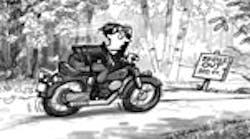Problem 200 — You need a good set of brakes to go the distance, as this month’s problem by Jerry Reckelhoff of Cincinnati demonstrates.
It was a sunny Sunday afternoon, and Finagel J. Wurme was enjoying an exhilarating ride in the country on his motorcycle. The picturesque lane he traveled at 60 mph had a downhill gradient of 5 deg. and crossed a babbling brook. Suddenly a sign, “Bridge Out 500 ft” jarred him out of his reverie. Wurme immediately hit the brakes, generating a constant braking force of 250 lb. If Wurme and motorcycle weigh a total of 750 lb, does Wurme end up in the brook? How many feet does it take him to come to a complete stop?
Send your answer to:
Fun With Fundamentals
POWER TRANSMISSION DESIGN
1100 Superior Ave.
Cleveland, OH 44114-2543
Deadline is January 10. Good luck!
Technical consultant, Jack Couillard, Menasha, Wis.
Solution to last month’s problem 199 — You are no Doubting Thomas if you answered 10 ft. Here’s how McGroundbound saw the light:
For the main-rotor blade to appear to be still, its tangential velocity must equal the helicopter’s linear velocity, but be in the opposite direction. Let:
v = Helicopter’s linear velocity, given as 150 knots or 253 fps
ω = Tangential velocity of main-rotor blade, radians/sec
r = Radius of main-rotor blade that appears to be standing still, ft
From physics,
That means the rotor was turning at 4 rps. Plug these values into (1):
